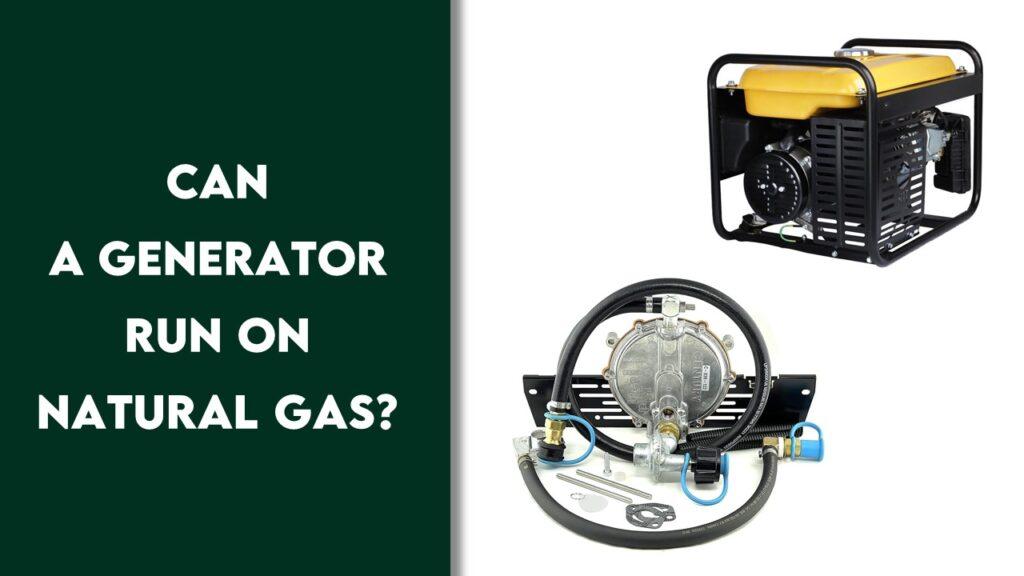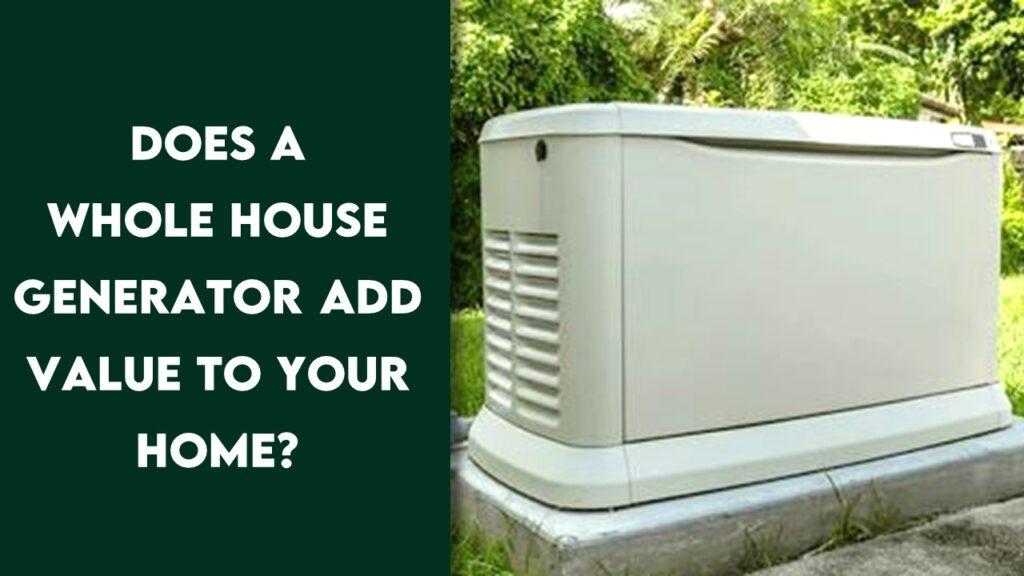
Yes, many generators can run on natural gas, either as a built-in feature or by using a conversion kit. Natural gas is a clean-burning, reliable fuel that’s perfect for home backup systems. To use it, you’ll need the right fittings, a steady gas supply, and a few setup steps to get everything running smoothly.
In this article, we’re going to show you how natural gas generators work, how to safely connect one to your gas line, and what to consider before making the switch. Whether you’re upgrading or just exploring options, these steps will help you do it the right way.
What Are Natural Gas Generators?
A natural gas generator is pretty much what it sounds like: a generator that runs on natural gas instead of traditional fuels like gasoline or diesel. These are great for a couple of reasons. They can hook right up to your home’s gas supply, so you don’t have to mess around with refueling. In the campervan world, having a generator that’s low maintenance is a game changer. You get the same reliable power without the usual generator hassle.
These generators aren’t just for homes; they come in portable versions too. That means you can take them along on trips without worrying about fuel spills or storing extra gasoline. Just connect to a natural gas source, and you’re good to go.
What Are The Benefits of Using Natural Gas for Your Generator?
Switching to natural gas for your generator? Smart move. Here’s why it makes sense:
- Cost-Effective: Over time, natural gas can be cheaper than buying gasoline or diesel, especially if you’re using your generator a lot at home or on long RV trips.
- Eco-Friendly: Natural gas burns cleaner. This means you’re not only saving money but also doing your bit for the planet by cutting down on emissions.
- Reliability: Natural gas lines are pretty reliable. This means you’re less likely to run out of fuel, especially during critical times like power outages.
- Maintenance: Generators that run on natural gas are usually easier to maintain. There’s less grime and no need to stabilize fuel for storage.
All in all, natural gas generators are a practical choice. They save you money, help the environment, provide reliable energy, and cut down on maintenance work. Whether you’re powering a house during an outage or living the RV life, natural gas could be the way to go.
How Can You Convert Your Generator to Run on Natural Gas With The Conversion Kit?
If you’re wondering whether it’s possible to switch your regular generator to natural gas using a conversion kit, the answer is yes—it’s totally doable.
What Is A Conversion Kit?
A conversion kit is a setup that lets your generator accept natural gas as a fuel source instead of just gasoline or diesel. It usually comes with a few parts—like a gas regulator, a spacer (sometimes called a snorkel), hoses, clamps, and fittings. Some kits are pretty basic, while others come with everything you need down to the screws.
The idea behind the kit is simple: it helps your generator get the right mix of air and gas so it can run smoothly without having to change the engine itself. You’re not rebuilding the whole machine—you’re just helping it breathe a different kind of fuel.
There are kits made for specific generator models and some universal ones too. I always recommend getting one that’s made for your generator or at least verified by others who’ve used it on the same unit. Saves you a headache later.
Step-by-Step Conversion Process
Once you’ve got your kit, here’s a quick rundown on how to actually set it up.
- Step 1: Make sure the generator is completely off and cool. Safety first—don’t work on it when it’s hot or running.
- Step 3: Remove the air filter cover and take out the filter. You’ll probably have to unscrew the air box to get better access.
- Step 5: Install the spacer or snorkel (whichever your kit uses) between the carburetor and air box. This is what allows the gas to flow properly into the carb.
- Step 7: Mount the gas regulator on the generator’s frame. Some folks drill into the frame, but I usually use light bar clamps to avoid that mess.
- Step 9: Connect the hose from the gas line to the regulator and then to the spacer. Make sure the connections are tight—no leaks.
- Step 11: Open the gas valve slowly, and follow the instructions on how many turns to give (usually written in the kit manual).
- Step 13: Start the generator and check if it runs smooth. If it sputters or stalls, you might need to tweak the air/gas mix a bit.
That’s pretty much it. It’s not a five-minute job, but it’s not rocket science either. If you can handle a screwdriver and follow instructions, you’ll be fine.
Converting your generator with a kit isn’t just about using a different fuel—it’s about making your setup more flexible and often more budget-friendly. If you camp a lot or live in an area with natural gas lines, this could make life easier and cheaper in the long run.
Can A Generator Efficiently Run on Natural Gas Without Compromise?
Many people wonder if switching to natural gas means giving up power or efficiency. The truth is, natural gas generators can perform well—but there are a few things to weigh against traditional fuel types.
Efficiency and Performance
When it comes to efficiency, natural gas generally produces slightly less energy per unit compared to diesel or gasoline. For example, diesel has a higher energy density, meaning you get more power out of the same volume. That’s why diesel generators are often used in industrial settings where consistent high output is needed.
Natural gas, while cleaner, tends to deliver about 10% to 15% less wattage compared to diesel. In real-world use, this might not matter much if the generator is sized correctly. But for high-load tasks or continuous demand, the lower BTU output of natural gas might mean a bigger generator is needed to match the same performance.
Running Costs Comparison
Fuel cost is where natural gas shines. In many areas, natural gas is significantly cheaper than gasoline or diesel. Running a 7,000-watt generator for 10 hours could cost $10–$15 on gasoline, $8–$12 on diesel, and around $4–$6 on natural gas, depending on local rates.
For home users or RV owners who use their generator frequently, those savings add up. Maintenance costs are usually lower too, as natural gas burns cleaner, leaving behind less residue and reducing wear on the engine over time.
Natural gas generators may not always match diesel in raw power, but they make up for it in lower fuel costs and simpler maintenance. For most residential and light commercial uses, the trade-off is well worth it.
What Safety Considerations Should Be Made?
Running a generator on natural gas can be safe—but only if proper steps are followed. From installation to daily use, safety should never be an afterthought.
Installation Safety
During installation, it’s important to use the right tools and parts. All connections should be properly sealed and tested for leaks. Working with a licensed technician or plumber is highly recommended, especially when tying into a permanent gas line. Good ventilation is also key—never install a generator in an enclosed or poorly ventilated space.
If using a conversion kit, mounting it securely and ensuring the hose connections are tight and properly routed can prevent accidents. Loose fittings are a common cause of gas leaks and fire hazards.
Operational Safety
Once up and running, regular checks for gas leaks are a must. Soap and water solution can be used to test connections. Any smell of gas or hissing noise should be taken seriously—shut everything down and investigate before restarting.
It’s also important to keep generators away from windows, vents, and doors to avoid carbon monoxide buildup. While natural gas burns cleaner than gasoline or diesel, it’s still combustible, and improper use can be dangerous.
With the right setup and regular checks, running a generator on natural gas can be just as safe as any other fuel type. Paying attention to proper procedures during setup and operation makes all the difference.
How Much Pressure Does a Natural Gas Generator Require?
Natural gas generators do require a specific pressure to operate safely and efficiently. It’s not a one-size-fits-all number—different generators have different needs, especially when comparing portable units to whole-house standby models.
Here’s a more accurate breakdown:
- Most residential standby generators (like Generac, Champion, etc.) require natural gas pressure between 3.5″ to 7″ water column (WC) — which is equal to 0.125 to 0.25 PSI. This is considered low-pressure natural gas and is the standard delivered by most residential gas lines in the U.S.
- Some larger or industrial natural gas generators may require 10″ to 14″ WC (0.36 to 0.5 PSI), depending on load demands and the specific engine design.
- Portable generators that have been converted to run on natural gas using a conversion kit typically also use low-pressure gas, but they can sometimes work better with slightly higher pressure around 11″ WC, especially if running heavy loads.
- If you’re drawing gas from a long line or using multiple gas appliances, pressure drop can occur, and the generator may starve for fuel—so a dedicated gas line with a regulator is often recommended.
- A two-stage or step-down regulator may be necessary when the main supply pressure is higher than what the generator accepts.
Just for reference:
- 1 PSI = 27.7 inches of water column
- So, 7″ WC ≈ 0.25 PSI (¼ PSI)
Without proper gas pressure:
- The generator might not start.
- It could sputter, surge, or run inconsistently.
- In worst cases, it might trip due to low fuel supply or shut off completely under load.
So, always check your generator’s spec sheet. Pressure too low, and it struggles. Pressure too high, and you risk damage or unsafe operation. Getting a licensed plumber or technician to measure and regulate gas pressure is a smart call—especially when tying into household supply.
If you’re setting up a natural gas generator, knowing your gas pressure isn’t just a technical detail—it directly affects performance and safety. A simple pressure gauge or manometer can save you hours of troubleshooting down the road.
Practical Tips for Maintaining a Natural Gas Generator
Keeping a natural gas generator in good shape doesn’t take much, but regular upkeep can go a long way. These quick tips will help extend its life and avoid common problems.
- Run it regularly – Starting the generator every few weeks helps keep internal parts lubricated and identifies any startup issues early.
- Check for leaks – Use a soap and water solution to spot bubbles around fittings or hoses that could signal a gas leak.
- Clean the air filter – A dirty filter chokes airflow and reduces performance. Check and clean it monthly or as recommended.
- Inspect the spark plug – Worn or fouled plugs can make it hard to start. Replace them if they look dirty or burned.
- Keep the area clear – Make sure there’s enough ventilation around the generator to avoid overheating or carbon monoxide buildup.
- Tighten connections – Vibration during use can loosen nuts, bolts, and hose clamps. Give everything a once-over regularly.
A little attention now saves a lot of trouble later. These small habits can keep your generator ready to go when you need it most.
Wrapping It Up!
A generator can absolutely run on natural gas—with or without a conversion kit. Whether you’re setting up backup power for your home or taking your RV off-grid, natural gas is a solid option if it’s available in your area. It’s cleaner, burns steady, and you don’t have to store it like gasoline or diesel.
Natural gas generators come in different types—standby, prime, or even dual/tri-fuel models—and each has its own pros depending on how and where you plan to use it. You can also convert your existing gasoline or propane generator using a proper kit, as long as you match it to your unit and follow safety steps.
While you might get slightly less power output compared to diesel, the lower running cost, fewer emissions, and easier maintenance make it a pretty fair trade-off. If gas lines are reliable where you live or travel, switching to natural gas can make your generator setup simpler, cleaner, and more cost-effective in the long run.
Related FAQs
Can all generators run on natural gas?
Not all generators can run on natural gas by default. You’ll need a natural gas model or use a conversion kit to modify it.
Is it safe to convert a gasoline generator to natural gas?
Yes, it’s safe if done properly using a certified conversion kit. All connections must be leak-free, and a regulator is necessary.
Will natural gas affect my generator’s performance?
Natural gas may slightly reduce power output (about 10–15%) compared to gasoline or diesel, but it’s cleaner and cheaper.
How long can a natural gas generator run continuously?
A properly sized natural gas generator can run non-stop for days, as long as the gas supply is steady and it’s well-maintained.
Do I need a regulator for a natural gas generator?
Yes, a regulator is needed to maintain the correct pressure (typically 3.5″–7″ WC) for safe and efficient operation.

Matt Riggins has spent years working with generators, solar panels, transfer switches, batteries, fuel setups, and circuit wiring. He’s the guy friends and neighbors call when the power goes out or something just won’t run right. From off-grid installs to fixing up old or new portable units, he’s been through it all. Alan doesn’t just talk theory, he’s out there solving real problems and helping people keep their systems running when it matters most.




